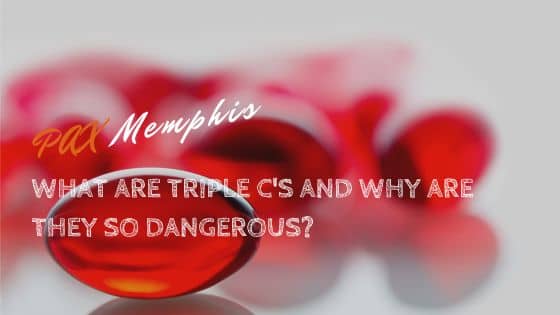Triple C is a slang term for a cough and cold medicine named Coricidin Cough and Cold. This is an over-the-counter medication that contains dextromethorphan, a cough suppressant. Dextromethorphan may also be referred to as “DXM.”
According to the DEA, “DXM is often abused in high doses by adolescents to generate euphoria and visual and auditory hallucinations.”[1]
Because teens often abuse Triple C’s and other medications containing DXM, some states have restricted access to people under the age of 18. Unfortunately, some states have not adopted these age restrictions, allowing minors to easily access the medication at drug stores and grocery stores.
If you are worried that your teen is abusing Triple C’s, it is important to be aware of what they are and the dangers of abusing them.
The Effects of Triple C Abuse
Triple C’s contain dextromethorphan (DXM), which belongs to the same class of drugs as ketamine. Triple C’s can cause dissociative effects, making them a popular drug of abuse. Because DXM blocks the effects of NMDA glutamate receptors in your brain, large doses of the substance can lead to hallucinations, euphoria, auditory changes, and more.
The effects of Triple C abuse will depend on the dosage taken and can be divided into four plateaus:[2]
- Plateau 1 – This stage of Triple C intoxication is characterized by euphoria, auditory changes, and a floating feeling. Someone would have to consume 1.5-2.5mg of the substance per kilogram of body weight to reach this plateau. For a 120-pound teen, this is equivalent to 8 to 14 pills.
- Plateau 2 – During this stage, euphoria intensifies and you may experience closed-eye hallucinations. You would have to consume 2.5 to 7.7mg of DXM per kilogram of body weight to reach this plateau which is equivalent to a 120-pound teen taking 138 to 412mg of the substance.
- Plateau 3- The third plateau is associated with an altered state of consciousness and significant hallucinations. You can also lose vision at this level of Triple C intoxication. You would have to reach 7.5mg of DXM per kilogram of body weight and up.
- Plateau 4- This stage of intoxication can cause someone to be completely unaware of their body and only notice hallucinations. Being this intoxicated on DXM can be extremely dangerous. You would have to have at least 7.5mg of the substance per kilogram of body weight to reach this plateau.
Some teens may take up to four 24-count packages of Triple C’s, which is equivalent to about 15 to 20mg of DXM per body weight in a 120 lb person. Taking this much dextromethorphan could result in an overdose.
The Dangers of Triple C Abuse
While large quantities of Triple C’s can lead to an overdose, most stores do not allow people to buy them in bulk, making it less likely for your teenager to be able to access enough DXM to overdose. However, individuals who are abusing this substance may go to multiple stores to buy more medication.
Abusing Triple C’s can lead to overdose, addiction, and liver damage.
Liver Damage
Triple C’s not only contain dextromethorphan, but they also contain acetaminophen. While acetaminophen is generally safe to take and is available over the counter, taking doses over 4000 mg can lead to significant organ damage.
One Triple C pill contains 300 mg of acetaminophen, so you could sustain liver damage if you routinely abuse half a package of Triple C’s.[3]
Addiction
While Triple C’s are thought to be less habit-forming than other drugs like cocaine and heroin, you can still become addicted to them. When you abuse dextromethorphan long-term, your brain will begin to rely on the substance to function properly. Once you are dependent on the substance, you will experience symptoms of withdrawal if you suddenly stop taking them.
The symptoms of DXM withdrawal include:[4]
- Fatigue
- Flashbacks
- Constipation
- Insomnia
- Anhedonia
- Memory and attention issues
- Panic attacks
- Tremors
- Hives
- Toxic psychosis
Overdose
If your teen abuses Triple C’s, they have to consume high doses to experience mood-and-mind-altering effects, placing them at significant risk of experiencing an overdose.
The symptoms of a Triple C overdose include:
- Breathing problems
- Blue fingernails and lips
- Blurred vision
- Coma
- Constipation
- Seizures
- Drowsiness and dizziness
- Hallucinations
- Slow and unsteady walking
- Changes in blood pressure
- Nausea and vomiting
- Muscle twitching
- Pounding and rapid heartbeat
- Heightened body temperature
- Stomach and intestine spasms
If your teen displays any of the above symptoms of a DXM overdose, contact emergency medical services immediately.
Find Help for Over-the-Counter Drug Abuse and Addiction
If you or a loved one abuse over-the-counter drugs like DXM or Triple C’s, help is available. You might believe that Triple C abuse is safe because you can buy them without a prescription, however, this is not the case. DXM abuse can lead to liver damage, addiction, overdose, and death.
PAX Memphis can connect you with a highly-rated addiction treatment center. Contact us today to learn more about how to get started.
References:
Medically Reviewed: September 25, 2019

All of the information on this page has been reviewed and verified by a certified addiction professional.










